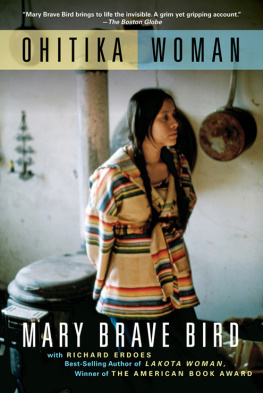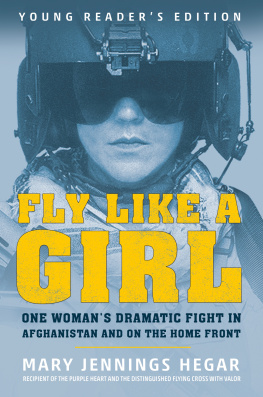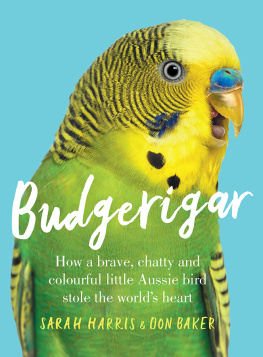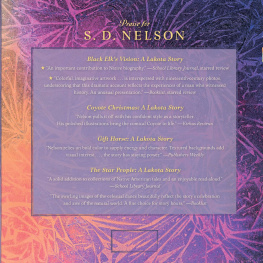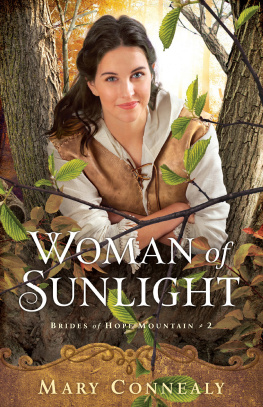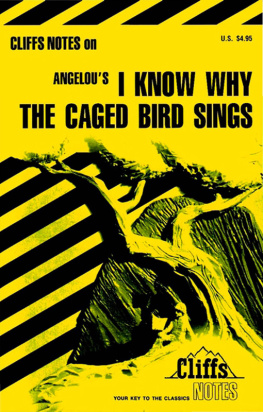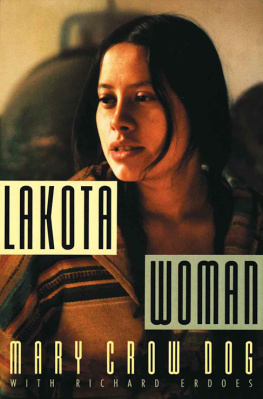Copyright 1993 by Mary Brave Bird and Richard Erdoes
All rights reserved. No part of this book may be reproduced in any form or by any electronic or mechanical means, including information storage and retrieval systems, without permission in writing from the publisher, except by a reviewer, who may quote brief passages in a review. Scanning, uploading, and electronic distribution of this book or the facilitation of such without the permission of the publisher is prohibited. Please purchase only authorized electronic editions, and do not participate in or encourage electronic piracy of copyrighted materials. Your support of the authors rights is appreciated. Any member of educational institutions wishing to photocopy part or all of the work for classroom use, or anthology, should send inquiries to Grove Atlantic, 154 West 14th Street, New York, NY 10011 or .
Published simultaneously in Canada
Chapter 4, Life in Paradise, originally appeared in The Missouri Review .
Library of Congress Cataloging-in-Publication Data
Brave Bird, Mary.
Ohitika Woman / Mary Brave Bird, with Richard Erdoes.
p. cm.
ISBN: 978-0-8021-4339-6 (pbk.)
eISBN: 978-0-8021-9156-4
1. Brave Bird, Mary. 2. Brule womenBiography. 3. Brule IndiansPolitics and government. 4. American Indian Movement. I. Erdoes, Richard. II. Title.
[E99.B8B733 1994]
937.04975dc20
[B] 94-18040
Designed by Laura Hugh
Cover design by Wendy Lai
Cover photograph courtesy of Richard Erdoes
Grove Press
an imprint of Grove Atlantic
154 West 14th Street
New York, NY 10011
Distributed by Publishers Group West
www.groveatlantic.com
Instead of a Foreword
T his book is the result of a collaboration between two oddly paired human beingsan old white man and a young Native American woman. Our backgrounds could not be more different. I, Richard Erdoes, have been raised in Vienna, as a member of a family of actors and opera singers. I came to America at the age of twenty-eight, and even though I have lived in the United States for a lifetime, I am culturally still more European than American.
Mary Brave Bird, up to recently known as Mary Crow Dog, was born and raised in the tiny settlement of He Dog, on the Rosebud Sioux reservation, a member of the Brul, or Sichangu, Tribe, one of seven tribes making up the larger Lakota Nation. While I was raised in the shadows of medieval cathedrals and ancient baroque buildings, Mary grew up on the prairie, where, as the old saying has it, there is nothing between you and the North Pole but a barbed-wire fence. In spite of our different backgrounds, Mary and I have two things in common: We both grew up fatherless. Four weeks before I was born, my own father died of double pneumonia after an exhausting series of performances at the Buda- pest opera. Marys father deserted his family while she was still a baby. And both of us had been youthful rebels fighting the powers that ruled over us. As a twenty-year-old art student I had been a member of the anti-Hitler movement in Austria and Germany, while as a teenager Mary had joined AIM, the American Indian Movement, fighting against racism and oppression. Mary and I finally met as the result of an accident.
During the first twenty years of my life in New York City I worked exclusively as an artist, particularly as a book and magazine illustrator. In 1964, two national magazines sent me west to do a painting portfolio and a photo essay on Indian reservations. This led to lasting friendships with several Native American families, many of them Sioux. One old medicine man, John Fire Lame Deer, insisted upon my doing his book. In spite of my protests that I was an artist, not a writer, and that English was my second language, he kept saying: My medicine tells me that youll write my story. This went on for years until I finally gave in, and to our surprise, the book, Lame Deer; Seeker of Visions, became a classic in Native American literature. Lame Deer changed me from an artist into a writer, though I still paint whenever I have a chance.
The Indian civil rights movement started some ten years after the struggle for Black Power, but when it hit the Sioux reservations it did so with a vengeance. By 1970 many of the sons and daughters of my older Lakota friends had joined AIM. As a result my wife, Jean, and I became heavily involved ourselves. In November 1972, Jean, I, and our two sons took part in the Trail of Broken Treaties, which ended in the occupation of the Bureau of Indian Affairs Building in Washington, D.C. Mary was there too, sixteen and pregnant, but on that occasion we were not aware of each other.
At that time I was especially close to the Crow Dog familyOld Henry, his wife, Mary Gertrude, and their son, Leonard, who was the medicine man of the American Indian Movement. After having given birth to her first child, Pedro, during the siege of Wounded Knee in April 1973, Mary married Leonard, Indian style, and moved in with him at Crow Dogs Paradise. It was there that I first met her face to face. She was small, feisty, very pretty, and standoffish. I heard her say once, during those days of confrontation: There might be a good white man someplace, but I never met one yet. Observing the close bond existing between my family and the Crow Dogs, she tolerated my presence, ignoring me most of the time. I didnt mind, having learned something of her terrible experiences at a white-run boarding school and with redneck racists. When she couldnt avoid contact with us, she was politely cool.
In the aftermath of Wounded Knee and the big shoot-out at Oglala in May 1975, which resulted in the death of two FBI agents and one Native American, my wife and I became heads of a defense committee for Leonard Crow Dog and a few other Lakota friends who were indicted for strictly political offenses. Crow Dog was tried at Cedar Rapids, Iowa, and Rapid City and Pierre, South Dakota, and was convicted in every case. While he was released on probation by the judge at Cedar Rapids, the one at Pierre ordered him to be at once taken to prison. In handcuffs, waist chain, and leg-irons, he was dragged away so quickly that I did not even have a chance to tell him good-bye. At the time South Dakota was considered the most racist state in the Union as far as Native Americans were concerned; it was said that even Jesus Christ himself would have been found guilty of a heinous crime there had he been an activist Indian.
Crow Dog was sent to Lewisburg, Pennsylvania, to serve his time. The prison was some eighteen hundred miles distant from the Rosebud Reservation but could be reached by car from New York in a couple of hours. I therefore proposed to Mary that she move in with us, together with her baby, so that she could be near her husband. She stayed with us for almost a year and it was then, living together in the same apartment, that we finally became close friends. Even so it took her a long time before she hugged and kissed us as she did her Indian friends. She was as sassy, outspoken, and brutally honest as ever, but also bewildered, wide-eyed, and lost in what she called the canyons of the big city.


